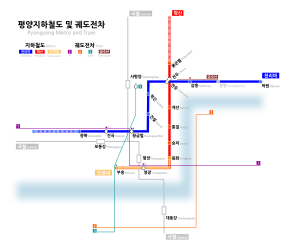Pyongyang Metro
The Pyongyang Metro (Korean: 평양 지하철도; MR: P'yŏngyang Chihach'ŏlto) is the rapid transit system in the North Korean capital Pyongyang. It consists of two lines: the Chollima Line, which runs north from Puhŭng Station on the banks of the Taedong River to Pulgŭnbyŏl Station, and the Hyŏksin Line, which runs from Kwangbok Station in the southwest to Ragwŏn Station in the northeast. The two lines intersect at Chŏnu Station.
Daily ridership is estimated to be between 300,000 and 700,000.[2][3] Structural engineering of the Metro was completed by North Korea, with rolling stock and related electronic equipment imported from China.[4][5][6] This was later replaced with rolling stock acquired from Germany.[7]
The Pyongyang Metro has a museum devoted to its construction and history.
Construction
Construction of the metro network started in 1965, and stations were opened between 1969 and 1972 by former president Kim Il-sung.[8][9] Most of the 16 public stations were built in the 1970s, except for the two most grandiose stations—Puhŭng and Yŏnggwang, which were constructed in 1987. In 1971, there was a major accident during the construction of a tunnel under the Taedong River for the Ponghwa Station. Some sources say at least 100 workers died in the accident.[10] This particular section of tunnel was never completed; the metro network is now completely located on the western side of the river.
China had provided technical aid for the metro's construction, sending experts to install equipment made in China, including electrical equipment made in Xiangtan, Hunan[11] and the escalator with vertical height of 64 m made in Shanghai.[12][13]
Pyongyang Metro is among the deepest metros in the world, with the track at over 110 metres (360 ft) deep underground; the metro does not have any above-ground track segments or stations. Due to the depth of the metro and the lack of outside segments, its stations can double as bomb shelters, with blast doors in place at hallways.[14][15] It takes three and a half minutes from the ground to the platform by escalator. The metro is so deep that the temperature of the platform maintains a constant 18 °C (64 °F) all year.[16] The Saint Petersburg Metro also claims to be the deepest, based on the average depth of all its stations. The Arsenalna station on Kiev Metro's Sviatoshynsko-Brovarska Line is currently the deepest station in the world at 105.5 metres (346 ft).[17] The Porta Alpina railway station, located above the Gotthard Base Tunnel in Switzerland, was supposed to be 800 m (2,600 ft) underground, but the project was indefinitely shelved in 2012.[18]
In 2018, commercial satellite imagery revealed possible extensions to the metro system, with activity showing three possible new underground facilities being constructed to the west of Kwangbok Station. NK News sources speculated an absence of announcements from state media was due to funding issues, as well as construction accidents during previous tunneling, which may have killed dozens of workers in the 1970s.[19]
In 2019, Kaeson station and Tongil Station were modernised, adding TVs that show the next service and brighter lighting. This was followed by Jonu station and Chonsung station in 2020.[20]
Operation
The Pyongyang Metro was designed to operate every few minutes. During rush hour, the trains can operate at a minimum interval of two minutes. The trains have the ability to play music and other recordings.[21]
The Pyongyang Metro is the cheapest in the world to ride, at only five North Korean won (worth half of a US cent) per ticket.[22] Instead of paper tickets, the Metro previously used an aluminium token, with the emblem of the Metro minted on it and the Korean "지". It now uses a paper ticket system, with "지" printed with blue ink on it. Tickets are bought at station booths and scanners are present but non functional. Smoking and eating inside the Metro system is prohibited and is punishable by a large fine.
Network
The Pyongyang Metro network consists of two lines:
- Chollima Line, named after a winged horse from ancient Korean mythology. It spans about 12 kilometres (7.5 mi). Construction started in 1968, and the line opened on September 6, 1973. The Mangyongdae Line forms part of the Chollima Line. The total route contains the Puhung, Yonggwang, Ponghwa, Sŭngni, Tongil, Kaeson, Jonu, and Pulgunbyol stations.
- Hyŏksin Line, which literally means renewal, spans about 10 kilometres (6.2 mi). Regular service started on October 9, 1975. The route contains the Kwangbok, Konguk, Hwanggumbol, Konsol, Hyoksin, Jonsung, Samhung, and Rakwon stations. The closed Kwangmyong station is located between the Samhung and Rakwon stations.
Unlike most railway systems, the majority of the stations' names do not refer to their respective locations; instead, stations take their names from themes and characteristics reflecting North Korea's revolution. A notable exception, Kaesŏn Station ("Triumph station"), is located at the Arch of Triumph.
The network runs entirely underground. The design of the network was based on metro networks in other communist countries, in particular the Moscow Metro.[23] Both networks share many characteristics, such as the great depth of the lines (over 100 metres (330 ft)) and the large distances between stations. Another common feature is the Socialist realist art on display in the stations - such as murals and statues.[24] Staff of the Metro have a military-style uniform that is specific to these workers. Each Metro station has a free toilet for use by patrons. Stations also play state radio-broadcasts and have a display of the Rodong Sinmun newspaper.
In times of war, the metro stations can serve as bomb shelters.[25] For this purpose the stations are fitted with large steel doors.[26] Some sources claim that large military installations are connected to the stations,[27] and also that there exist secret lines solely for government use.[2][28]
One station, Kwangmyŏng, has been closed since 1995 due to the mausoleum of Kim Il-sung being located at that station. Trains do not stop at that station.
The map of the Hyŏksin line shows two additional stations after Kwangbok: Yŏngung (영웅) and Ch'ilgol (칠골), both of them reportedly under development. The map of the Chollima Line, on the other hand, shows four additional stations, two at each end of the line—Ryŏnmot (련못), Sŏp'o (서포), Ch'ŏngch'un (청춘) and Man'gyŏngdae (만경대)—also planned or under development.
In addition to the main system for passenger use, there is reportedly an extra system for government use, similar to Moscow's Metro-2. The secret Pyongyang system supposedly connects important government locations.[29] There is also reportedly a massive underground plaza for mobilization, as well as an underground road connecting two metro stations.[30]
Rolling stock
When operations on the Metro started in the 1970s, newly built DK4 passenger cars were used, made for North Korea by the Chinese firm Changchun Railway Vehicles. A prototype train of DK4 cars was constructed in 1971 and the first 15 cars were sent to Pyongyang on July 30, 1973. 112 cars had been provided to North Korea by September 1978,[31] but eventually 345 cars were acquired.[32]
The Chinese-made rolling stock was later sold back to China for use on the Beijing Subway, where it was used in three-car sets on line 13. It has since been replaced by newer DKZ5 and DKZ6 trainsets, and it is not known if the DK4 units were returned to Pyongyang. Other sets have been observed operating near the Sinuiju area.[33]
Since 1997, the Pyongyang Metro has used former German rolling stock from the Berlin U-Bahn. The North Korean government supposedly bought more than twice the number of trainsets required for daily use, prompting speculation that the Metro might contain hidden lines and/or stations that are not open to the public.[29] There are two different types of rolling stock:
- GI ("Gisela"), former East Berlin stock, 60 built between 1978 and 1982.
- D ("Dora"), former West Berlin stock, 108 built between 1957 and 1965.
The trainsets were given a new red and cream livery in Pyongyang. All advertising was removed and replaced by portraits of leaders, Kim Il-sung and Kim Jong-il. In 2000, a BBC reporter saw "old East German trains complete with their original German graffiti".[7] After about 2006, Type D cars were mainly used. The type GI rolling stock was withdrawn from Metro service in 2001, and those cars are now operating on the railway network around Pyongyang and northern regions.[34]
In 2015, Kim Jong-un rode a newly manufactured four car train set which was reported to have been developed and built at Kim Chong-t'ae Electric Locomotive Works in North Korea,[35] although the cars appeared to be significantly renovated D-class cars.
Some class D sets have a next stop indicator installed, replacing the portraits of Kim Il-sung and Kim Jong-il.[36]
The shunting locomotives used on the Pyongyang Metro are the GKD5B diesel electric model manufactured by China's CNR Dalian, imported in early 1996.[37]
Tourism
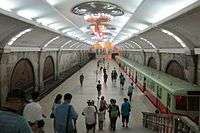
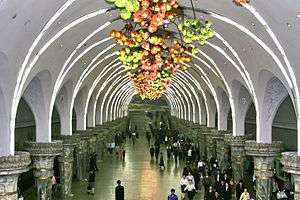
In general, tourism in North Korea is allowed only in guided groups with no diversion allowed from pre-planned itineraries. Foreign tourists used to be allowed to travel only between Puhŭng Station and Yŏnggwang Station.[38] However, foreign students were allowed to freely use the entire metro system.[39] Since 2010 tourists have been allowed to ride the metro at six stations,[40] and in 2014 all of the metro stations were opened to foreigners. University students traveling with the Pyongyang Project have also reported visiting every station.[41]
As of 2014, it is possible for tourists on special Public Transport Tours to take metro rides through both lines, including visits to all stations.[42] In April 2014, the first tourist group visited stations on both metro lines, and it is expected that such extended visits to both metro lines will remain possible for future tourist groups.[43]
The previously limited tourist access gave rise to a conspiracy theory that the metro was purely for show. It was claimed that it only consisted of two stops and that the passengers were actors.[44][45][46]
Museum
Pyongyang Metro has its own museum. A large portion of the collection is related to President Kim Il-sung providing "on-the-spot guidance" to the workers constructing the system. Among the exhibits are a special funicular-like vehicle which the president used to descend to a station under construction (it rode down the inclined tunnels that would eventually be used by the escalators), and a railbus in which he rode around the system.[47]
Gallery
 Mural at Puhŭng Station entrance
Mural at Puhŭng Station entrance.jpg) Staff in a military-style uniform
Staff in a military-style uniform A public newspaper display on a platform
A public newspaper display on a platform.jpg) A statue of Kim Il-sung at Kaesŏn Station
A statue of Kim Il-sung at Kaesŏn Station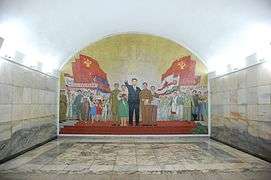 Socialist realist mural at Ponghwa Station
Socialist realist mural at Ponghwa Station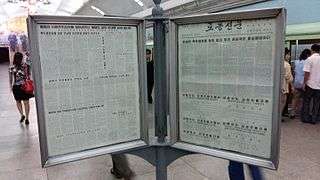 9 September 2015 newspaper at Puhŭng Station
9 September 2015 newspaper at Puhŭng Station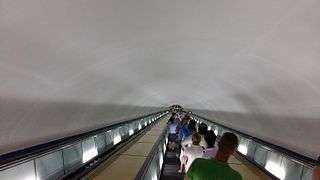 Escalators at Puhŭng Station
Escalators at Puhŭng Station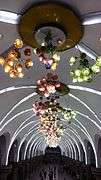 Chandelier at Yŏnggwang Station
Chandelier at Yŏnggwang Station Mural at Puhŭng Station
Mural at Puhŭng Station Pyongyang Metro map at Kaesŏn Station
Pyongyang Metro map at Kaesŏn Station
References
Notes
- Michael Rohde. "Pyongyang". mic-ro.com.
- Harris, Mark Edward; Cumings, Bruce (2007). Inside North Korea. Chronicle Books. p. 41. ISBN 978-0-8118-5751-2.
- "CNN Special Investigations Unit: Notes from North Korea". CNN. 11 May 2008.
- 关于朝鲜地铁最早是中国修建的说法是真的吗?
- "China Releases Details on Aid to N.Korea". Choson Ilbo. 28 April 2011. Retrieved 14 February 2016.
- "中国第一笔援助是对朝鲜提供 平壤地铁系我援建". 中国网. 26 April 2011. Retrieved 14 February 2016.
- Lister, Richard (8 October 2000). "Life in Pyongyang". BBC News.
- "The Pyongyang Metro: Trains". pyongyang-metro.com.
- "철도동호회 - 조선국 평양지하철도 - Daum 카페". 철도동호회 - Daum 카페.
- "Станция "ПОНГВА" - "Путеводный Огонь"".
- "湘潭电机股份有限公司地铁产品". Xiangtan Electric Manufacturing Company Limited. Retrieved 15 February 2016.
- 罗菁 (31 October 2014). "申城38年援建国外198个成套项目 平壤地铁电梯为沪产". 东方网. Retrieved 15 February 2016.
- 李永林主编. 《吉林省志·卷三十三·对外经贸志》. pp. 444–445. ISBN 7206022952.
- Davies, Elliott (16 April 2016). "I was part of the first group of outsiders allowed to ride the entire North Korean subway system — here's what I saw". Business Insider. Retrieved 17 April 2016.
- 平壤的表情:你不知道的朝鲜 (in Chinese). Netease. 31 July 2007.
- 任力波 (17 February 2005). "平壤地铁 站台内常年保持18摄氏度恒温". Xinhua. Retrieved 15 February 2016.
- Официальный сайт киевского метрополитена. Kiev Metro.
- "World's Longest Tunnel Drilled Under Swiss Alps". DNews.
- O'Carroll, Chad (25 April 2018). "North Korea extending Pyongyang metro system, sources say". NK News. Archived from the original on 11 December 2019.
- "Underground Pyongyang Is Getting Young". KCNA Watch. Retrieved 8 July 2020.
- One minute riding the Pyongyang metro to the tune of Rossini's "il barbiere di siviglia". YouTube. 25 April 2014.
- Hooi, Ng Si (6 September 2008). "A world of its own". The Star (Malaysia).
- Korea: North-South nuclear issues : hearing before the Subcommittee on Asian and Pacific Affairs of the Committee on Foreign Relations, House of Representatives, One Hundred First Congress, second session, July 25, 1990. U.S. G.P.O. 1991. p. 85.
- Ishikawa, Shō (1988). The country aglow with Juche: North Korea as seen by a journalist. Foreign languages Pub. House. p. 65.
- Robinson, Martin; Bartlett, Ray; Whyte Rob (2007). Korea. Lonely Planet. p. 364. ISBN 978-1-74104-558-1.
- Springer, Chris (2003). Pyongyang: the hidden history of the North Korean capital. Entente Bt. p. 125. ISBN 978-963-00-8104-7.
- Min, Park Hyun (20 August 2007). "Pyongyang Subway Submerged in Water". Daily NK.
- "Kim Jong-il 'Has Secret Underground Escape Route'". The Chosun Ilbo. 1 March 2011.
- "The Pyongyang Metro: Statistics". pyongyang-metro.com. Archived from the original on 30 January 2016. Retrieved 13 June 2016.
- "Mammoth Underground Square and Road in Pyongyang". Digital Chosunilbo (English Edition) : Daily News in English About Korea. Archived from the original on 7 February 2005. Retrieved 13 June 2016.
- [李永林主编. 《吉林省志·卷三十三·对外经贸志》. pp. 444–445. ISBN 7206022952.
- http://www.pyongyang-metro.com/metronews.html
- "平壌地下鉄-車両紹介". 2427junction.com. Retrieved 19 July 2020.
- "Metro News". pyongyangmetro.com. 2006. Archived from the original on 28 September 2007.
- North Korea Leadership Watch (19 November 2015). "Kim Jong Un Rides the PY Subway". Retrieved 12 December 2015.
- "平壌地下鉄-D型". 2427junction.com. Retrieved 19 July 2020.
- 李炳华. "大连机车车辆厂为朝鲜地铁工程提供GKD5型调车内燃机车". 内燃机车 (1997年第01期). Retrieved 15 February 2016.
- Burdick, Eddie (2010). Three Days in the Hermit Kingdom: An American Visits North Korea. McFarland. p. 57. ISBN 978-0-7864-4898-2.
- Abt, Felix (2014). A Capitalist in North Korea: My Seven Years in the Hermit Kingdom. Tuttle Publishing. p. 226. ISBN 9780804844390.
- "North Korea". testroete.com.
- Pyongyang metro - 6 stops visited in April 2014. YouTube. 25 April 2014.
- Pyongyang Travel. "Public Transport Tours - Information Page". pyongyang-travel.com. Archived from the original on 15 April 2014. Retrieved 14 April 2014.
- "Tourists granted rare access to nearly all stations on Pyongyang metro network". nknews.org.
- Kate Whitehead (13 September 2013). "Touring North Korea: What's real, what's fake?". CNN.
- Hamish Macdonald (2 May 2014). "Tourists granted rare access to nearly all stations on Pyongyang metro network". NK News.
- Maeve Shearlaw (13 May 2014). "Mythbusters: uncovering the truth about North Korea". The Guardian.
- The forbidden railway: Vienna - Pyongyang 윈 - 모스크바 - 두만강 - 평양. vienna-pyongyang.blogspot.com.
- https://www.youtube.com/watch?v=FxjNF8ebN1g Pyongyang Metro Museum photo collection showing the exhibits
Bibliography
- Pyongyang Metro, Pyongyang: Foreign Languages Publishing House, 1980
- Пхеньянский метрополитен. Путеводитель. — КНДР: Издательство «Корея», 1988.
Further reading
- "Kim Jong-il 'Has Secret Underground Escape Route'". The Chosun Ilbo. 9 December 2009. Retrieved 12 December 2015.
- Gu Gwang-ho (June 2011). "Inspection At The Metro Station Entrance - "No Shabby Cloths, No Large Luggage!"". Rimjingang. Archived from the original on 3 March 2013. Retrieved 12 December 2015.
External links
| Wikimedia Commons has media related to: |


